Table of Contents
Introduction
Banana is considered as one of the most significant fruits of the tropics. As a global food commodity, bananas are regarded as the fourth most important.
Banana is the only tropical fruit that is exported in large amounts and is the leading fruit on the global market for international trade. Hence banana cultivation is considered as one of the most reliable agribusiness.
Banana cultivation has been practiced since ancient times. Bananas are among the oldest and most commonly available fruits in many parts of the world.
Tropical regions of South-East Asia, including India, Papua New Guinea, Malaysia and Indonesia, are believed to have given bananas their origin.
In terms of native banana varieties, India ranks second globally. Out of 600 germplasms reported worldwide, India has more than 300.
Bananas that are edible have been produced by a natural cross between Musa. paradisiaca and Musa. balbisiana.
India ranks 1st in terms of banana production, with 17 million tons of banana grown on 0.50 million hectares. Other countries practicing banana cultivation are Kenya, Uganda, Sudan, Fizi, Honduras, Hawaii, Canary Island, the Philippines, Taiwan, Australia, Bangladesh, South Africa, Pakistan, etc.
Banana also has a significant cultural and religious meaning in various religions.
Banana leaves were used by Eve to cover her modesty in the garden of paradise. Thus it is also called the “apple of paradise”.
Banana tree is also referred to as “Adam‘s fig” or “tree of wisdom“.
Because of the various uses of banana and banana tree (almost all the parts of a banana tree can be used or consumed by humans), in Hindu culture it is also sometimes referred to as “Kalpataru” (Sanskrit word for a tree which yields whatever that be desire).
Uses of banana and banana tree parts
Bananas are generally eaten as desserts or table fruits when ripe.
Aside from fresh consumption, certain types are also used in cooking. In fact, the staple food of many Central and Western African countries is the plantain or cooking banana.
Many delicious cuisines can be prepared using both the flower bud and the central core of the pseudostem of a banana tree.
A banana leaf can be used as a plate for serving food in many cultures, leaf sheaths can be used as a wrapping material in food preparation or in food transport and storage, and dried leaves can be burned as fuel.
Banana leaves, underground rhizomes, and tender pseudostems are also used as cattle feed.
The fruit can be processed into various products such as banana chips, candy, puree, powder, flour, vinegar, jam, jelly, and wine.
Using banana fiber, one can make attractive napkins, carry bags and table mats.
A banana is rich in medicinal properties and is used for treating a variety of ailments such as acidity, ulcers, joint pain, high blood pressure, and heart disease.
Banana is rich in nutrients and is a great source of energy. Full nutrition facts of banana can be seen here.
Some facts about banana and banana tree
- Banana is botanically considered as a berry.
- A banana tree, on average, produces 30-40 leaves in its life cycle, at the rate of 4 leaves per month.
- During the shooting period, the last leaf produced by the tree (which is the smallest) is called the flag leaf.
- Production of bract primordium is the first differentiating factor between vegetative and reproductive phases of a banana tree.
- Female flowers grow at the basal (proximal) nodes of the inflorescence, while male flowers grow at the upper (distal) nodes.
- Hermaphrodite flowers do not form edible fruits between male and female buds because their ovaries are stunted.
Climate requirement for banana farming
Tropical fruit crops such as bananas are adapted to a wide range of climatic conditions.
Up to 1200 meters above mean sea level, banana cultivation is possible.
Banana cultivation requires a temperature range of 13-40 degrees C.
Optimally, the temperature should be between 25 and 30 degrees C for good yields.
Weather conditions such as heavy storms, frost, low temperatures (less than 10 degrees Celsius) or extremely high temperatures are not conducive to plant growth. These conditions would lead to abnormal or malformed fruits.
Soil requirement for banana farming
Almost any type of soil can be used for banana cultivation, as long as it has adequate moisture.
The best soil for its cultivation is deep, loamy, well-drained, and rich in organic matter.
A slight alkaline soil is also suitable for banana farming.
Though bananas require large quantities of water, they are not tolerant of stagnant water.
The preferred soil pH for banana cultivation is 6.5-7.5.
Varieties of banana for farming
All edible bananas are descended from natural cross breeding of 2 wild ancestors, namely Musa acuminata (A) and Musa balbisiana (B).
These bananas are diploids, triploids, or tetraploids, meaning they have 22, 33 or 44 chromosomes, respectively.
Generally, there are more triploid cultivars, fewer diploid cultivars, and very few tetraploid forms. The standard haploid number is 11.
In the world, the most famous bananas are from the pure acuminata (AAA) group.
The clones with both parents, however, have better drought tolerance and resistance to diseases. For example AB, AAB, ABB, AA or AAA (suitable for rainy weather).
The following differences exist between M. acuminata and M. balbisiana according to Simmonds and Shephered (1995);
| S No. | Characters | Musa acuminata | Musa balbisiana |
|---|---|---|---|
| 1 | Colour of pseudostem | Heavily marked with black or brown blotches | Blotches slightly or absent |
| 2 | Peduncle | Usually downy or hairy | Glabrous |
| 3 | Pedicel | short | Long |
| 4 | Ovules | Two regular rows in each loculus | Four irregular rows in each loculus. |
| 5 | Bract curling | Bracts roll after opening | Bracts lift but do not roll |
| 6 | Bract shape | Lancedote or narrowly ovate tepering sharply. | Broadly ovate not tapering sharply |
| 7 | Bract apex | Acute | Obtuse |
| 8 | Bract colour | Red, dull purpose or yellow outside, pink dull purple inside | Brownish purple outside bright crimson inside |
| 9 | Male flowers colour | Creamy white | Variably flushed with pink |
| 10 | Stigma colours | Orange or rich yellow | Cream, pale yellow. |
The genetic composition of banana cultivars
Banana cultivation is done in the southern, eastern, central and north eastern parts of India, between 800 and 300N latitudes. They are most commonly AA genomic groups.
AA– Anaikomban, Matti, Kadali, Tongat, pisanglilin.
AB– Ney poovan (Elakki bale), Kunnan, Nathu Poovan. Thaen kunnan, Adakka Kunnan.
AAA– Dwarf Cavendish/Basrai, Giant Cavendish, Robusta, Gross michel, Grand naine, William, Nagabale, Chenkadali/Red banana, Chakkarakeli, Amrit sagar.
AAB– Poovan, Rasthali, Pachanadan/Kaali/Galibale, Nendra paditha, Rajapuri, Virupakshi/Sirumalai, Nendran/Rajeli, Chinali.
ABB– Nalla Bontha, Monthan/Kanchkela, Keribontha, Peyan, Karpuravalli, Sugandhi.
AAAA– Bodles Altafort, IC-2.
AAAB– Atan, Goldfinger (FHIA).
AABB– Kalamagol
ABBB– Klue Taparod
Some banana varieties and their characteristics
- Ney poovan/Elakkibale/Elakki Bale/Yelakki (AB):

Kerala and Karnataka are the two states that grow it commercially.
The plants are medium in size, with slender, yellowish pseudostems, with reddish petiole margins.
The flesh of small fruits is firm, sweet, and fragrant.
Typically, a bunch weighs 12 kg.
Despite the plant’s tolerance to leaf spot and fusarium wilt, it is susceptible to the banana bract mosaic virus.
2. Kunnans (AB):

It is an indigenous cultivar of Kerala and Karnataka.
Fruits of this plant are medium-sized and slender with a firm pulp. They are mostly used as infant food after being converted into banana flour.
Moreover, it is resistant to leaf spots and wilts caused by fusarium.
3. Dwarf Cavendish/Basrai (AAA):
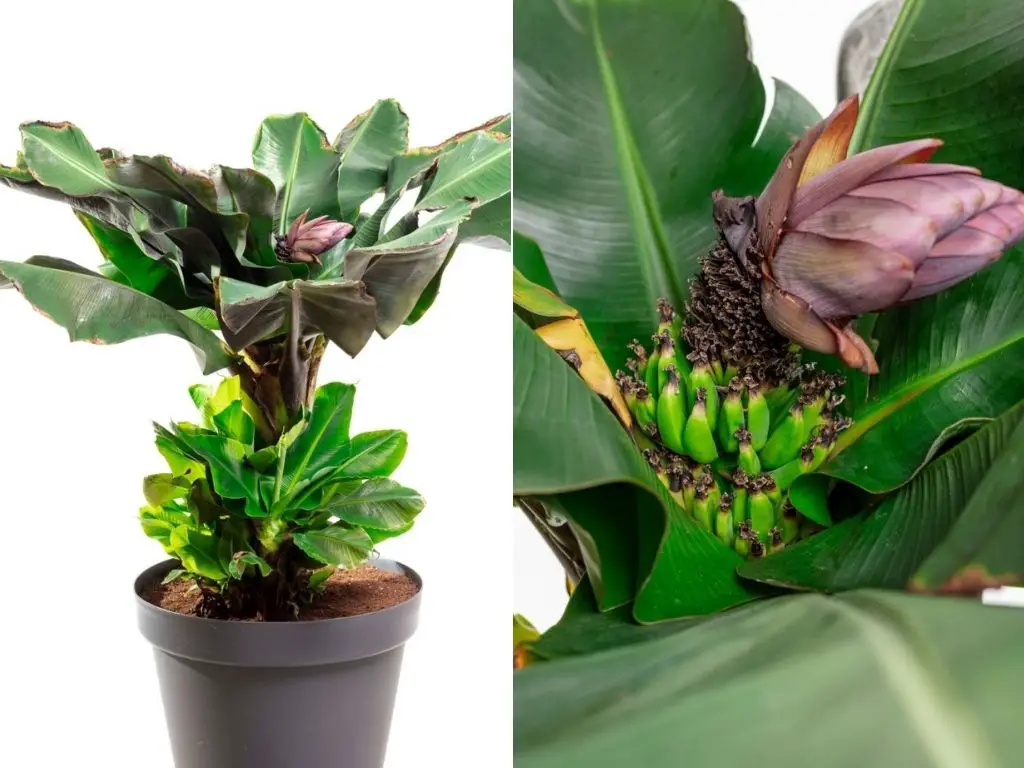
This variety belongs to Cavendish sub-group. The most important commercial cultivar of India is this variety. The plant is dwarf, fruit is large, curved, with thick greenish skin, and soft – sweet pulp.
The fruit remains green even after it is ripened, however, fruits ripening during the winter season turn yellow in colour.
The storage quality is poor.
About 20kg is the average bunch weight.
High density banana cultivation is possible with this variety.
Leaf spot disease is a risk with this variety.
4. Gros Michel (AAA):

This variety belongs to Cavendish sub-group. The Gross Michel banana cultivar had dominated the world banana trade until the late 1950s.
Despite this, the variety is susceptible to panama wilt and has lost its commercial status.
5. Red Banana (AAA):

The variety belongs to the Red Banana Subgroup. It is cultivated around the world.
Purplish red is the color of the pseudostem, petiole, midrib and fruit peel.
There is a distinct aroma to the fruit, and it is of a good size.
20 kg is the average bunch weight.
The plant does well in humid tropical climates and at higher altitudes.
The plant is highly susceptible to bunchy top, fusarium wilt, and nematodes.
6. Rasthali/Rastali (AAB):

Bananas in this variety belong to the silk subgroup. It is one of the most widely grown commercial cultivars in West Bengal, Tamil Nadu, Karnataka, Andhra Pradesh, Kerala, and Bihar.
Plants of this species have tall stems that are characterized by yellowish green color and brownish blotches.
Petiole margins and leaf sheaths are reddish-brown in colour.
Around 12 kg is the average bunch weight.
Fruits are medium in size, thin-skinned, yellow in colour, with a firm, sweet flesh with pleasant aroma.
The disadvantages of this variety include longer duration for ripening, fusarium wilt susceptibility, and easier fruit dropping.
It is susceptible to sun damage and the formation of hard lumps in the pulp of the fruit.
7. Poovan/Champa (AAB):

This variety of banana belongs to the Mysore subgroup. Growing vigorously, the plant is tall, hardy, and hardy.
The midribs outside has a rose pink color, which makes the plant easily recognizable.
Fruits are medium to small in size with yellow skins, firm flesh and sub-acidic tastes.
It is a good variety for storing bananas.
About 15kg is the average bunch weight.
Plants in this genotype are resistant to panama wilt and bunchy top. It is, however, highly susceptible to banana bract mosaic and streak virus.
Some other varieties of banana for cultivation
- Boodibale
- Grand Naine
- Karibontha
- Karpooravalli
- Monthan
- Nendran
- Virupakashi
Propagation in banana farming
Traditionally, bananas are propagated vegetatively by suckers, rhizomes or tissue culture plants.
The parthenocarpic nature of fruits makes sexual reproduction impossible.
In the absence of suckers, whole or split rhizomes can also be used for planting in banana cultivation.
It is also possible to plant rhizome bits as planting material for banana cultivation.
Technically, banana stems are tuberous rhizomes. Many authors have described the banana stem as a short rhizome in their botanical descriptions.
A mature rhizome has a diameter of about 300 mm and very short internodes covered with leaf scars externally.
Commercially, tissue cultured plants are also used as planting materials.
The concept of high density planting (HDP) has become increasingly popular in recent years.
To get higher yields and lower production costs, suckers are planted with closer spacing or two suckers are planted per pit in HDP.
IIHR recommends the cultivar Robusta and Dwarf Cavendish spaced at 1.5×1.5m to accommodate 4444 plants per ha. This cropping practice yielded a record harvest.
Banana suckers
Two types of suckers are produced by banana i.e. Sward sucker and Water sucker.
According to some authors, diploids produce the most suckers followed by triploids and tetroploids.
In comparison to balbisiana derivatives, Puer accuminata diploids and triploids produced more suckers.
Sucker production is greatly determined by the nutritional condition of the mother plant.
It was found that cultivars with greater nutrient uptake produced more suckers with the same ploidy level.
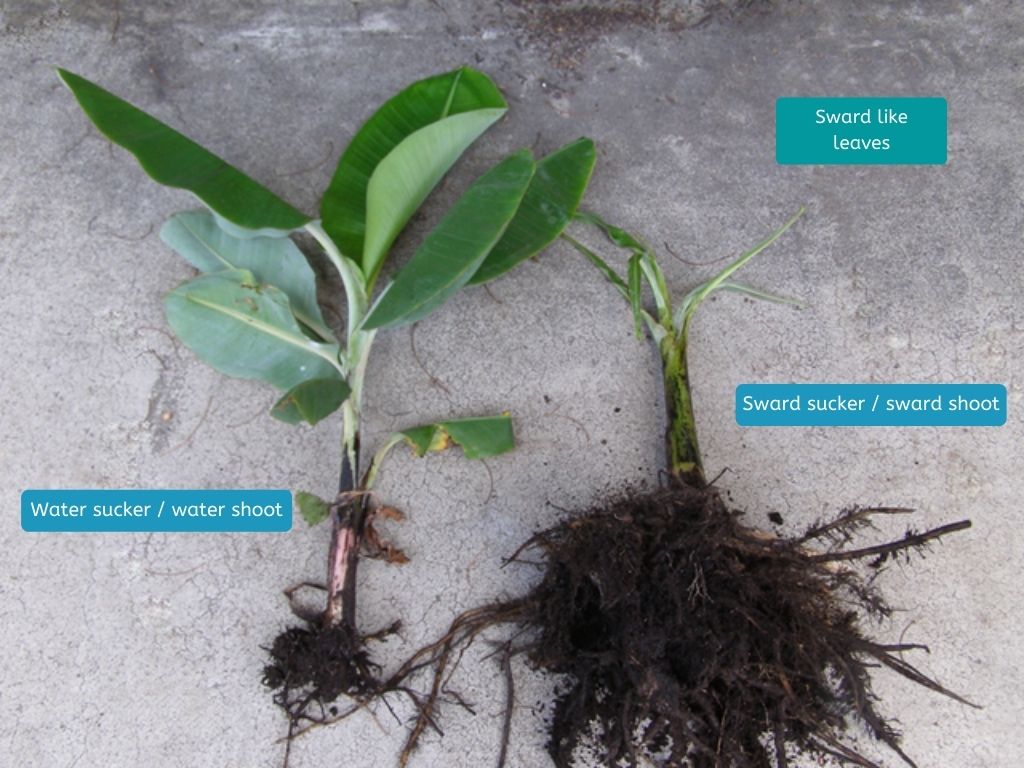
(i) Sword sucker
- The water sucker has broader leaves that do not produce a healthy banana clump, along with a slender pseudostem.
- These types of suckers are formed from shallow buds that develop away from pseudostems near the soil surface.
- Rhizome/corm development is not good.
- It takes more time (over 18 months) for the plants to bear fruit.
- Furthermore the yield is also less.
(ii) Water sucker
- A sword sucker has a well developed rhizome, a well developed pseudostem, and sword-like leaves.
- Due to their close association with the mother plant, sword suckers grow strong thick rhizomes of their own.
- The plant takes 12-13 months to yield and has larger bunches.
How to select banana suckers for banana planting
- Orchards and mother blocks should be disease-free.
- The suckers should weigh between 1.0 and 1.5 kg.
- A heavy yielding mother plant is ideal.
- For planting, always choose sword suckers.
- Rhizome weevils should not be present on the suckers.
- Suckers should be between 3 and 4 months of age
How to prepare suckers for banana planting (Pairing & Prolinage)
This involves removing older leaves, roots, adhered soil and other particles from the surface of the rhizome and top portion of suckers leaving 15cm from the base of the rhizome.
For prevention of development of soil pathogens & rhizome weevils, soak the suckers in cow dung slurry and treat with phorate granules @ 10-15 g/rhizome.
The rhizomes are also dipped in fungicide solution by cutting them slantwise.
Planting in banana farming
A banana plant can be planted throughout the year, except in severe winters and when heavy rains occur. Banana planting typically occurs between June and July.
Two types of planting methods (Pit method and furrow method) are used for banana cultivation:
1. Pit method
A pit of approximate size 1.8×1.8 meter or 2×2 meter is dug.
The size of the pit is such that 20-30 kg of topsoil can be filled int he pit.
Planting should take place at least 15-30 days after application of FYM.
To prevent nematode & rhizome rot, each pit should be treated with 250gm of neem cake and 50gm of trichoderma before planting.
Irrigate immediately after planting suckers in the center of the pit.
Spacing between the plants depends on the type of banana variety being used for banana cultivation.
2. Furrow method
Planting by this method is the most common method.
Rhizomes are planted in furrows that are 15-20cm deep. Again, the spacing is decided depending on the variety of banana being cultivated.
Tissue culture plants for banana planting
Tissue cultured plants are also used to grow bananas commercially.
During the growth period of these plants, they required a lot more care as compared to suckers.
However, the banana yield is around 10-20 percent greater than suckers.
Water requirement and management in banana farming
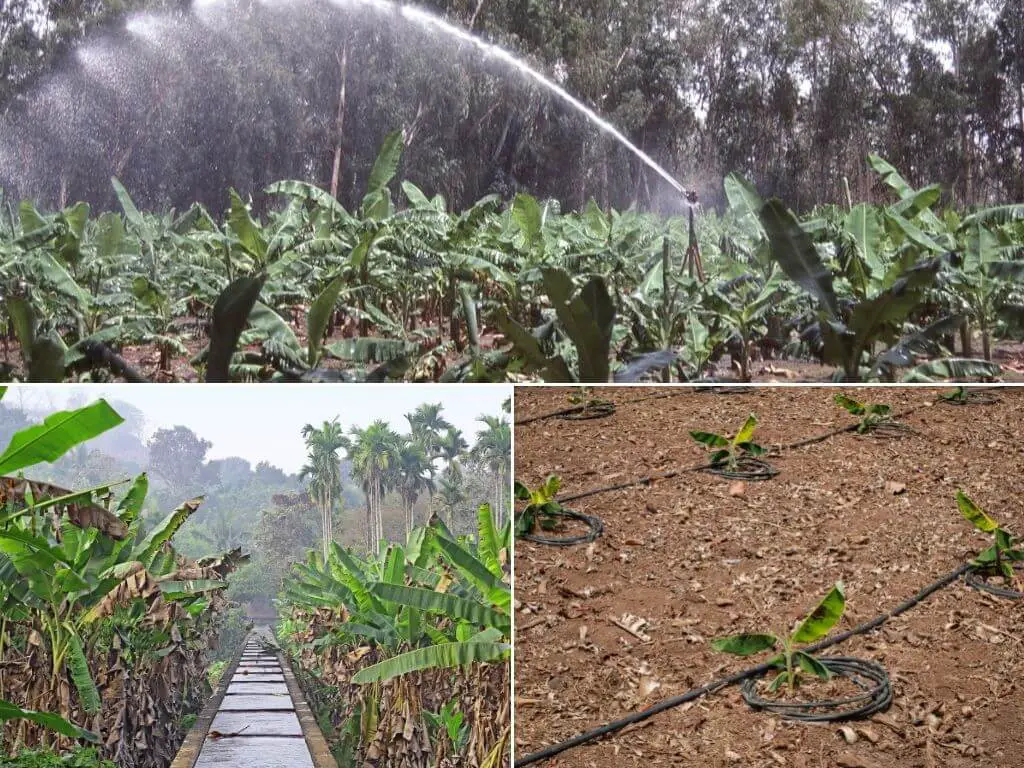
For banana cultivation, the soil should be kept moist all the time. Making sure that the soil doesn’t go completely dry is very important.
A banana plant requires high amounts of water, ranging from 1800 to 2500 millimeters annually.
Irrigation should be done at an interval of 4-5 days.
From planting to harvest, approximately 40-45 irrigation are needed.
Fertilization and Nutrient Management for banana farming
Since bananas have shallow roots, they respond well to supplemental nutrients. Banana trees can consume a lot of nutrients.
This heavy consumption of nutrients can be attributed to the banana tree’s vigorous growth and high yield of fruit.
| STATE / VARIETY | Nitrogen (N) | Phosphorus (P) | Potasium (K) | FYM |
|---|---|---|---|---|
| ANDHRA PRADESH | 200 grams/plant | - | 200 grams/plant | 40 tonnes/ha |
| KARNATAKA | ||||
| Dwarf cavendish | 540 Kilogram/ha | 325 Kilogram/ha | 675 Kilogram/ha | 40 tonnes/ha |
| Robusta | 405 Kilogram/ha | 245 Kilogram/ha | 507 Kilogram/ha | 40 tonnes/ha |
| others | 400 Kilogram/ha | 240 Kilogram/ha | 500 Kilogram/ha | 40 tonnes/ha |
| KERALA | ||||
| Nendran | 190 grams/plant | 115 grams/plant | 300 grams/plant | 10 Kilogram/ha |
| Others | 160 grams/plant | 160 grams/plant | 320 grams/plant | 10 Kilogram/ha |
| MAHARASHTRA | 600 grams/plant | 720 grams/plant | 600 grams/plant | 100 carts/ha |
| TAMIL NADU | 110 grams/plant | 35 grams/plant | 330 grams/plant | 10 Kilogram/ha |
| Source : ICARICAR |
Generally, fertilizer is applied before initiation of inflorescence in 3 splits. This is done by application of fertilizers in the 2nd, 4th and 6th month.
Apply fertilizers 30 to 45 cm from the base of the plant by collecting them in a basin, mixing them in with the soil, and then irrigating the plant.
* A must read: Types of fertilizers
Weed Management in banana farming
Weeds are a problem in bananas at the beginning of their growth.
In banana cultivation, a weed-free environment is critical to moisture conservation, proper nutrient utilization, and pest and disease control.
Cover crops, herbicides, inter-cropping, and hand weeding are all part of an integrated weed management program that should be practiced.
Diuron, applied at 4kg/ha, controls grasses and broadleaf weeds without affecting banana yield and quality
Weed growth was effectively controlled with the use of 2kg/ha Glyphosate followed by 1.8kg/ha Gramoxone.
Care should be taken to avoid excessive use of herbicide for prevention of development of herbicide resistance in weeds.
Application of plant growth regulator in banana farming
- The flowering process in banana tree is governed by Gibberlin-like substances, which also aids in the development of plants. This is followed by anthecin hormone induced flowering in the banana tree.
- The effect of both the harmones combined together is called “Dual factors hypothesis“.
- Fruit size and yield significantly increase when 100 ppm of NAA is sprayed after 5 and 7 months of planting.
- The fruits exhibited high quality after the application of 2-4 D@20ppm. As it is poured into the growing apex, more female flowers/fingers will be produced.
- In Giant Governor Banana, application of GA3 at 50mg/litre resulted in maximum yield and shorter maturation time.
* A must read: What is bio-fertilizer ?
Best practices in banana farming
- Earthing up
The pseudostem is surrounded by a mound of soil during rainy season to prevent it from being uprooted by wind.
- Denaveling
The process of removing male buds after the last set of fruits. The process increases the weight of the bunch/fruits as well as the quality of the fruit.
- Bunch covering

Protection of banana bunches against cold, sun scorching, attacks by thrips and other scraping insects during bunch maturity by bagging them with perforated polythene or dried leaves. Pesticides can be applied to the external part of the bags.
- Desuckering
During desuckering, the pseudostem of the sucker is cut at the ground level and kerosene/2-4, D @ 0.5 percent is applied.
Furthermore, sucker growth can be inhibited by inflicting damage to the cut end.
If banana plants are allowed to produce more suckers, they compete for moisture nutrition with the mother plant. Therefore, one or two sword suckers should be allowed to grow for the ratoon crop.
- Propping
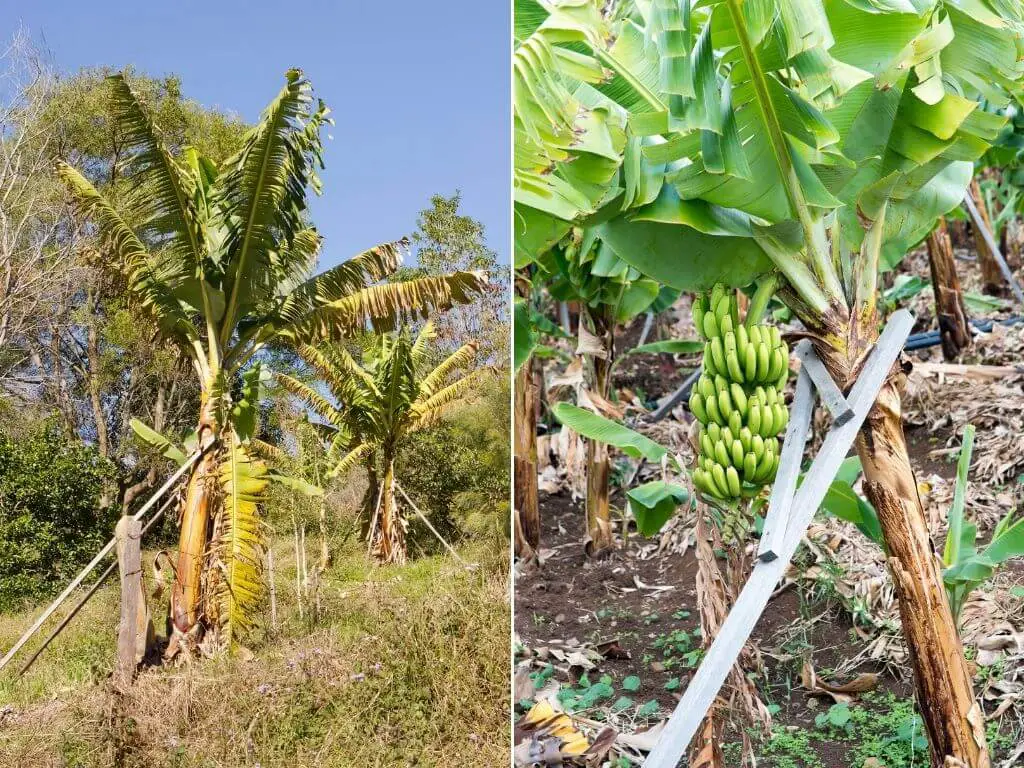
At the time of bunching, provide support to the plant.
No propping is necessary for dwarf varieties and closed spacing banana plantations, but it is required for all tall varieties.
The support can be provided with bamboo poles.
- Thrashing
During this process, old, dry, diseased, and senescent leaves are removed, allowing better light, temperature, and air flow.
Pruning leaves before bunch initiation, however, delays flowering and increases cycle time.
For maximum yields, at least twelve leaves must be retained.
- Mattocking
After banana bunches have been harvested, the pseudostem is cut.
It is recommended that the pseudostem is cut after harvesting, leaving a stump about 0.6m high.
This stump nourishes the daughter/follower sucker with the nutrition stored by it. it eventually decays and dries up.
Harvesting in banana farming
Bananas start flowering in 9-12 months under ideal conditions.
On an average, it takes approximately 4-5 months for fruits to mature, depending on variety, climate, elevation etc.
The banana is harvested at 3/4th maturity stage for distant markets (export purposes) or chip making purposes. While, for local markets, the banana is harvested at full maturity.
It is recommended to harvest banana bunches with 2 ft of peduncle left on them.
The following are signs that a banana is mature:
- Top leaves of the banana tree are dried.
- Fruit becomes light green from green.
- Fruits shed their floral ends with a slight hand touch at the apex.
- Fruits become plump and angles quickly disappear.
- A fruit or two are ripe at the basal end (yellow in color).
- The fruit contains 22-25 percent starch.
Yield of banana farming
The banana variety and banana cultivation practices affect banana yield.
Typically, tall cultivars yield 15-20 tonnes per hectare.
About 40t/ha are produced by varieties in the Cavendish group.
In contrast, hill bananas and cooking bananas yield between 11-15 tonnes per hectare.
Post harvest management in banana farming
In general, bananas aren’t allowed to ripen on trees.
In summer, smoking should be done for 18-24 hours in a closed chamber with straw leaves & cow dung. In winter, the smoking process can take 48 hours. For uniform ripening, banana bunches can later be transferred to ventilated rooms.
When 100 ppm of ethylene gas is applied in an enclosed chamber for 24 hours, uniform colour and ripening of banana can be achieved.
For 3 weeks, bananas can be stored at about 13 degrees Celsius with a relative humidity of 85-95 %. Ripening occurs in one week at about 16.5-21.0 degrees Celsius.
Refrigerated conditions are not recommended for banana storage.
By storing the fruits in high carbon dioxide and low oxygen concentrations, the storage life of the fruits can be extended.
In addition, store the banana in sealed polythene bags containing ethylene absorbents like potassium permanganate. This will slow down the ripening process.
Waxol (12%) treatment or shrink film wrapping can extend shelf life up to three weeks.
Pest in banana farming
- Banana aphid – Virus responsible for bunchy top
- Pseudostem borer – The borer attacks most commercial cultivars. An exudate of plant sap is the first symptom, and a blackened residue comes out of the holes created by the larvae.
- Fruit and leaf scarring beetle – The beetle eats young leaves and skin of young fruits, and it is most prevalent during the rainy season.
- Rhizome weevil – Affected corms display feeding tunnels filled with an abundance of rotting tissue. Nendran is highly susceptible to pathogens.
Diseases in banana farming
- Leaf spot/Sigatoka
The condition is caused by a fungus. Yellowish spots appear on the leaves in the initial stages of the disease.
In severe infestation, the spots turn light grey in colour surrounded by a brown ring.
Leaf spot or Sigatoka is highly contagious among Gros Michel and Cavendish group (AAA). Whereas, all of the ABB banana clones are resilient.
- Banana bunchy top virus (BBTV)
Aphid vector, Pentalonia nigronervosa, is responsible for this disease.
There is a high risk of this disease in dwarf banana cultivars.
At the top, the leaves form a rosette, and their margins are wavy and slightly rolled up.
Dark green streaks running along the midrib or lamina.
Because of this disease the plant has stunted growth and does not produce any crop of monetary value.
- Panama wilt
This disease is caused by Fusarium oxysporium F.sp cubens.
This disease is the most occuring disease in banana cultivation.
Rasthali banana cultivator is particularly vulnerable to the disease.
This disease is highly likely to occur in poorly drained soil.
Robusta & Dwarf Cavendish are resistant varieties to this disease.
Other diseases in banana farming
- Anthracnose
- Bacterial soft rot
- Bacterial wilt or moko disease
- Banana bract mosoic virus etc. causing damage to banana plants.
- Banana streak virus
- Cigar end tip rot
- Crown rot
- Diamond spot
- Pseudostem heart rot

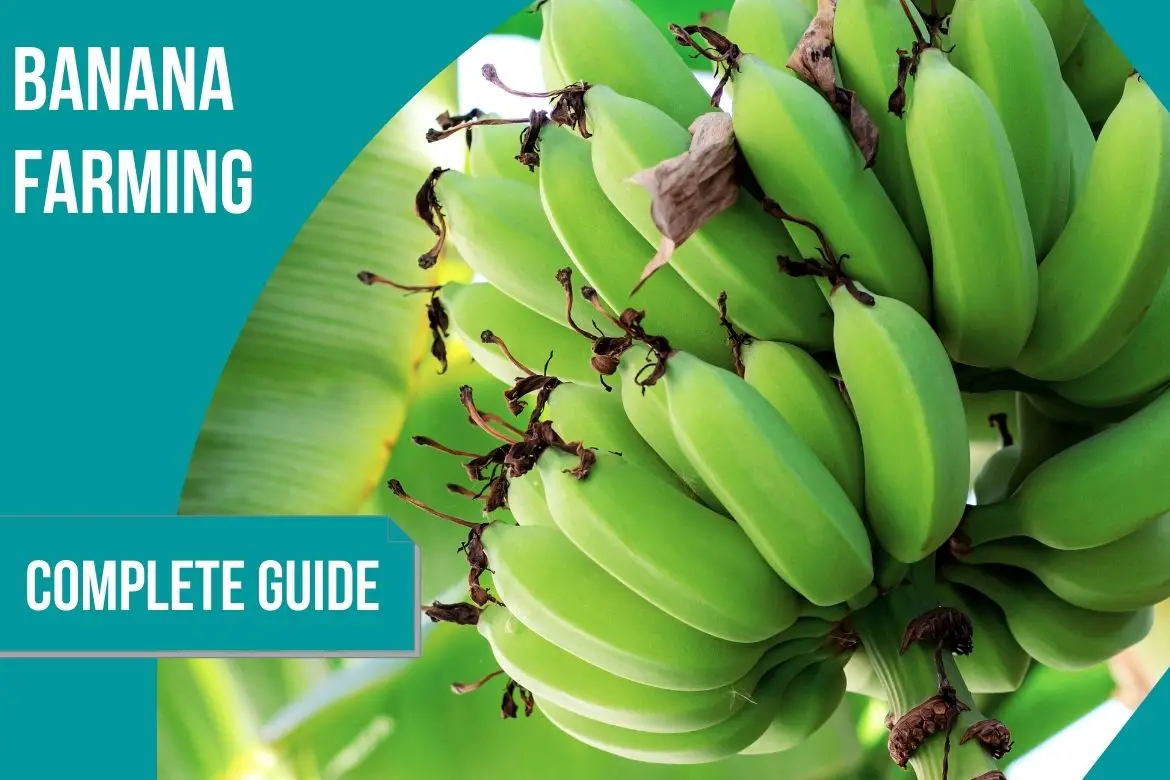
2 comments
Thanks
informative